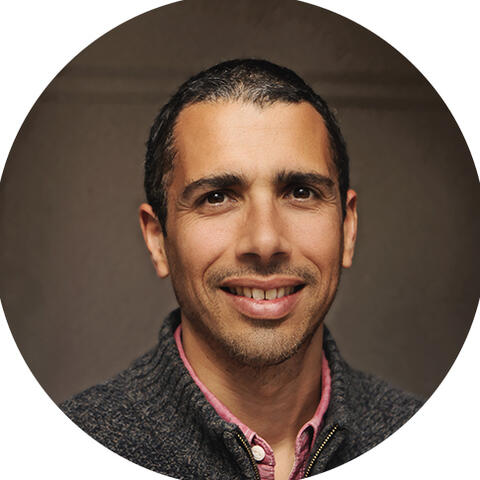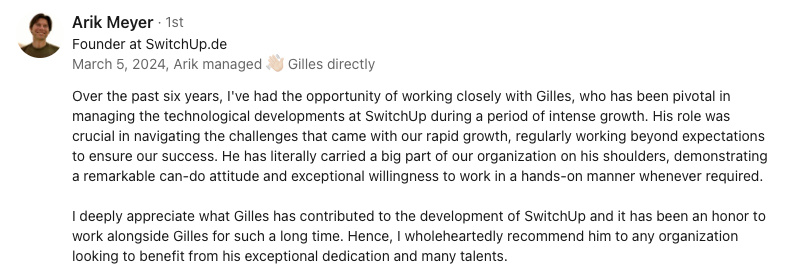Abstract:
The article challenges the relentless drive for constant advancement in tech careers, arguing that taking intentional pauses—or plateaus—can be both healthy and strategic. It explores the emotional toll of always striving for the next achievement and distinguishes between active, mindful plateaus and passive stagnation. Drawing on personal experiences, such as the author’s move from Berlin to Lisbon that allowed time for deeper learning and renewal, the article highlights how these quieter periods enable mastery, satisfaction, and sustainability. It discusses the pressures of achievement culture, the risk of burnout, and how reframing plateaus as periods of skill-building, rest, and reflection can lead to greater well-being and more innovative, resilient careers. Through practical tools for self-reflection, examples from workplaces like Google, and stories of professionals who found breakthroughs by slowing down, the article advocates for embracing non-linear career paths and celebrating steady progress. Ultimately, it positions holding steady not as falling behind, but as an essential and often overlooked form of progress in the tech world.
In tech, it can feel like everyone is always chasing after the next big thing. There’s a constant buzz around new languages, frameworks, or job titles. The pressure to keep growing never really stops. Whether it’s a performance review, a chat over coffee, or a quiet moment alone, the sense that you should always be moving up is everywhere. Many people quietly wonder if it’s okay to just stay where they are for a bit. Taking a break often feels risky—as if it means falling behind. But what if pausing is actually smart? What if holding steady is not just fine, but essential for learning more deeply and feeling content in the long run?
This article looks at why plateaus matter in tech careers, and how they can become some of the best times at work. You’ll find thoughts on the emotional weight of always growing, how healthy breaks are different from feeling stuck, and practical ways to see value in staying put. Topics include:
- The quiet pressure to keep advancing and how it affects our emotions
- The difference between a conscious pause and feeling stagnant
- How holding steady can help you build skill, feel satisfied, and stay resilient
- Mindset changes and tools to see plateaus as real wins
- Stories and examples of big changes that start with slowing down
- Ways to balance your career, even if everyone else seems to be hurrying
If you’ve ever worried about not working harder, or just want permission to settle in, this is for you. Sometimes, the best progress happens during quieter periods. Let’s see how a plateau might be your secret advantage in tech.
The Pressure to Always Grow in Tech
How advancement became the only story
In tech, staying in place is almost frowned upon. There’s always something newer to learn or another job to chase. Even a casual chat can turn into a subtle contest over the latest certification or project. I remember sitting in a Berlin café, listening to friends compare their latest AWS badges, and feeling a strange mix of pride and anxiety—like if I didn’t have something new to share, I was falling behind. Performance talks and promotions rely on the idea that everyone should keep moving up. It’s not just the companies, either. Sometimes, the pressure comes from inside.
The unspoken rulebook of self-worth
This push to keep moving gets inside how people see themselves. If you’re not learning a brand new skill or looking for a promotion, it can feel uncomfortable—even if you like where you are. I’ve caught myself feeling guilty for enjoying the comfort of a familiar project, as if I was cheating on my own ambition. The drive to grow doesn’t just come from bosses or coworkers. It becomes a personal standard, a little voice saying, Shouldn’t you be pushing harder? It's tough to escape this thinking.
When progress equals worth
The result is a belief that moving forward is what makes you valuable. Even those who work for themselves often feel odd about not pushing every day. The tech world’s focus on growth and agility sometimes becomes a trap that makes it hard to see when enough is truly enough. This high pace can take an emotional toll. Ambition and burnout start to blur, and it gets tough to accept the value of simply holding steady—even when that’s what’s really needed.
The Emotional Toll of Standing Still
Guilt and anxiety in the pause
When career progress slows down—by choice or not—guilt often follows. There’s a nagging thought: Am I falling behind? Wasting potential? For many in tech, this nagging is not just about the current job; it cuts to the core of who they are. These feelings can be lonely.
The loneliness of stability
Holding steady can feel isolating, especially when everyone else looks like they’re speeding ahead. People worry that pausing or just keeping things the same makes them invisible or forgettable. Freelancers and founders probably feel this even more. The worries pile up: Will I disappear? Lose value? Get forgotten?
Tech’s favorite stories make this worse. We hear about all-night sprints and dramatic wins, but the quieter paths—those times for reflection or just finding balance—rarely make headlines. This makes being content with a plateau harder. But what if taking a break could be a good thing? Maybe the stories worth telling are the quiet ones.
Understanding Intentional Plateaus in Tech Careers
Defining the intentional plateau
Not all plateaus are the same. An intentional plateau is a choice to stop climbing for a while. Instead of always reaching for a new role or flashy skill, a person might choose to stay put—to build expertise, recover from stress, or enjoy what’s already there. It’s not laziness or giving up. It’s a smart pause, done with a clear reason. Reasons might include:
- Getting really good at a current job
- Protecting health
- Enjoying earlier achievements
- Making time for reflection or personal interests
Some workplace research points out that these plateaus are not passive. They’re about choosing stability for good reasons.
Intentional plateau vs passive stagnation
Choosing to pause can feel strange in a field where constant change is expected. But there’s a big difference between making a conscious stop and just drifting. The real sign of an intentional plateau is ongoing curiosity and engagement. Even if new growth doesn’t show up on a resume, people on a plateau are still learning—getting better at their work, building better systems, or connecting with others. Quiet progress counts, too.
Here’s a snapshot:
Aspect Intentional Plateau Passive Stagnation Decision Deliberate, self-directed Unintentional Motivation Strategic, personal Disengagement Engagement Active, ongoing Often reduced Outcomes Performance, satisfaction Risk of dissatisfactionOngoing interest and engagement show the difference between a healthy break and being stuck.
Why intentional plateaus matter for tech
Intentional plateaus are still rare in tech, but organizations are starting to see their value. I’ve noticed some companies set up programs to let people hold steady and explore new ideas, instead of always pushing for the next big thing. This helps spark creativity and keeps people happier at work.
For example, according to a 2022 Stack Overflow survey, 43% of developers said they felt most satisfied in their roles during periods of stability, not during rapid advancement. Giving room for plateaus can spark both personal growth and company innovation. Knowing if you’re pausing for the right reason—or just stuck—can make the difference.
Plateau or Stuck? Finding the Line
It’s not always easy to tell a healthy plateau from feeling stuck. The key is whether the pause feels like your choice and fits your values. If you stopped moving up to learn something deeper, care for your health, or live more fully outside work, you’re probably on a healthy plateau. If you feel trapped, bored, or unclear, it might be time to reconsider.
Here’s a simple way to check:
Healthy Plateau Signs of Stagnation Chosen pause, fits your values Feels forced or accidental Ongoing curiosity and engagement Chronic boredom or apathy Satisfaction in achievements Falling motivation and energy Clear reason for staying put No clear goal or directionWatch out for warning signs if negative feelings stick around.
One insight that sticks with me: a friend once realized she was on a healthy plateau when she noticed she was still excited to solve new problems at work, even if her job title hadn’t changed in two years. She was learning, just not in a way that showed up on LinkedIn. That’s a sign you’re in the right place.
Recognizing warning signs of stagnation
Warning signs include:
- Boredom that won’t go away
- Falling performance or motivation
- Worrying about missed chances
- Feeling disconnected from peers or projects
- Growing frustration
On the flip side, a healthy plateau often brings quiet pride in doing things well and feeling content. Spotting the difference early can save time and prevent burnout. Reflecting can help clarify what phase you’re in.
Tools for self-reflection and feedback
Simple tools—like satisfaction checklists or mapping out your career—can make it easier to see where you stand. Listing out key moments of growth or answering honest questions about what you’re learning helps reveal unseen progress. Asking trusted peers for feedback gives you a reality check.
Helpful tools include:
- Career timeline: Mark your highs, challenges, and proudest moments to spot trends.
- 360-degree review: Get input from colleagues to see if your experience matches what others see.
Checking in regularly helps you spot if your plateau is healthy. Done right, these steady times create space for growth, both at work and in life.
The Three S’s
Deepening skills during plateaus
Focusing on one thing at a time might not look impressive, but it’s where deep learning happens. When you’re not chasing the next hot tool, you finally have space to master your work. Like a chef perfecting a favorite recipe, these moments can be repetitive but vital for real expertise.
Research on deliberate practice finds this is when subtle skills grow and confidence rises. Often, it’s the experts in tech who’ve spent years getting good at the basics—quietly learning while others hurry by.
Mastery happens in these hidden phases. It’s not about collecting new badges or certificates—it’s about making your knowledge strong and useful.
Studies show that people who deepen their expertise, not just collect new skills, usually do better over time. They also handle tech changes more easily. Some benefits of focusing on strengths:
- Higher job performance
- More protection from changes in tech
- Better job security and lasting satisfaction
You don’t always need to run after every new tool—sometimes, the best results come from sticking with what you’re already good at.
During my own time moving from Berlin to Lisbon, I spent months getting better at using data to inform decisions. No new job title, just time to think about what really mattered. That quiet period had a lasting effect on my work. Often, focusing on what moves you already have, instead of adding more, is enough.
Savoring satisfaction and stability
Stability doesn’t get much respect in tech, yet it has its own rewards. There’s comfort in knowing routines, building deeper relationships, and working on projects that don’t need a new fix every month. Plateaus make room to enjoy these quieter successes. It’s okay to feel good about things running smoothly for a while.
Studies say aiming for “good enough” instead of perfection leads to more happiness and less regret. In tech, enjoying what’s already working can prevent burnout. For many, the joy comes from more time outdoors, picking up a new hobby, a slower work pace, or deeper connections with others.
Dropping perfectionism can make work and life more satisfying. Sometimes, just being present is enough.
For those who’ve swapped big-city jobs for something slower, satisfaction can come from simple things: more time in the garden, working with your hands, enjoying slower days. It’s not about giving up—it’s about letting stability count as a win and finding peace in the present. This helps you enjoy the path, not just the next achievement.
Building sustainability for the long haul
Without breaks, even the most passionate tech workers risk burnout. Plateaus give space to rest, reflect, and recharge so you’re ready for what comes next. Think of them as recharging periods for your career. Recent research calls deliberate rest a driving force for creativity and strong performance, not a weakness.
Rest is not a lost time—it pays later with better ideas, less mistakes, and more healthy habits. Good careers move in cycles—work, rest, repeat. Some payoffs for rest: more creative thinking, less burnout risk, fewer costly mistakes, and better focus at work.
Real staying power in tech is not about always hustling. It’s about pacing yourself and making room for life outside work. Sometimes holding steady is the smartest move.
Psychological Shifts for Embracing Plateaus
Understanding achievement pressure in tech
The urge to achieve in tech often starts early—at school, coding camps, and training. Many in tech set big goals, always pushing for more. Social media and friend circles keep the pressure up, with someone always sharing their latest step up. No surprise that many start to fear falling behind, even on a Sunday at home.
The pressure doesn’t just stop after work hours—it becomes part of self-image. I remember one quiet Sunday in Lisbon, the sun pouring through the window, and still feeling that itch—like I should be learning something new instead of just enjoying the day. That pressure can sneak into every corner of your life.
Impostor syndrome and toxic productivity
Impostor syndrome is common in tech, especially when you stop advancing for a while. If you step back from chasing the next promotion and decide to focus on what you know, it’s easy to wonder if people will see you as less capable. Many professionals feel this way during quieter times. Instead of feeling proud, some feel anxious, worried that others will notice their lack of visible progress.
This is when toxic productivity sneaks in: it can make you feel like rest equals failure, and every pause is dangerous for your reputation. The real goal—growing skills or feeling good in your role—gets lost behind just trying to stay in the game. It’s a cycle that’s tough to break.
The trap of external rewards
Visible rewards like job titles or bonuses can be hard to resist, but they’re not always what brings satisfaction. The thrill of a new promotion doesn’t last, and just doing good work can feel overlooked if nobody sees it. The quiet wins—helping someone, fixing a hard problem, building something stable—matter just as much.
If all the praise goes to visible success, it’s tough to value holding steady. The good news is, you can shift how you view plateaus—as wins, not losses. Some often-missed wins could be:
- Earning trust from your team
- Solving a tricky bug
- Making space for life outside work
Turning plateaus into achievements
Journaling or writing reflectively can help you see progress during a plateau. Instead of focusing on what’s missing, jotting down what you enjoyed or learned can make quiet achievements visible. Even a weekly note about what felt satisfying at work helps shift the view from stuck to strategic. This kind of reflection builds self-awareness.
Some go further with narrative therapy, rewriting their career story to focus on stability as strength. For example:
- Instead of: I stopped advancing.
- Try: I built up my skills and helped my team.
It helps you reclaim the story and recognize value in staying put.
Connecting with others in peer groups or online spaces brings support too. Sharing the ups and downs normalizes the experience, making plateaus less lonely. Even a simple chat with peers about holding steady can remind you that you’re not alone. These moments of honesty show that quiet seasons have real value, especially with the right outlook.
Stories and Examples of Plateaus in Action
Breakthroughs that start with a pause
Some of tech’s best breakthroughs appear after a slowdown. Like the developer who chooses to stick to basics for a year instead of learning every shiny new tool. Such moments of focus often set up leaps in skill or creativity. People who take time to master the fundamentals are usually the ones who can solve tough problems or spark new ideas down the line. Real change often starts with a quiet pause, not a fast run.
A concrete fact: According to the 2021 GitHub Octoverse report, the most active open-source contributors often spend months refining existing projects rather than jumping to new ones—leading to more stable, widely adopted tools. Sometimes, the biggest impact comes from staying put and digging deeper.
Plateaus as pathways to influence
Some leaders use plateaus to shift from climbing up to growing wider. A manager who stays in the same job may use the time to mentor, champion change, or become an expert. Spending time on helping others or growing deep expertise makes them trusted voices at work. This kind of plateau isn’t standing still—it’s becoming a go-to person. Companies benefit too, since steady experts give teams strength and knowledge.
Innovation and organizational plateaus
Companies sometimes build formal plateaus into their culture. Google’s 20% Time famously gives employees a pause from regular projects to try new ideas. This planned downtime has led to big innovations, like Gmail. Pausing to step back, reflect, or experiment can spark creativity and keep work fresh. Even the busiest teams need slow time to recharge—and the little jokes about this approach show how much it matters.
Well-Being and Balance on the Plateau
Stability for well-being and team health
Choosing to hold steady in tech can make life richer. Research shows that those who slow down by choice often feel better, form deeper relationships, and have more room for hobbies and life outside work. Teams with a mix of steady and speedy workers stay healthier and avoid burnout.
But let’s be honest—balancing income and stability can be tricky during plateaus, especially if you’re freelancing or stepping away from a corporate job. When I moved from Berlin to Lisbon, I had to rethink my budget and accept a little uncertainty in exchange for more time and freedom. Sometimes, the price of stability is a smaller paycheck, but the payoff is a life that feels more like your own.
Some wins that come with plateaus:
- Work hours that match real life
- Time for personal passions
- Stronger bonds at work
- Better mental health and lower stress
It turns out, pausing can make work and life more enjoyable.
Plateaus as space for life
Plateau periods can help you get back to what matters outside the screen. After moving to Lisbon, slowing things down brought me focus and new energy. Gardening and carpentry became ways to step away and return later with fresh ideas and more patience. These slow seasons ended up bringing exactly the spark I needed for new work.
Cycles, not sprints, make healthy careers
Tech careers that last don’t look like one endless race. Instead, they grow in cycles—work, rest, then action again. Like seasons in a garden, plateaus have their purpose: they let things grow, help energy return, and open room for something new. Learning to spot and respect these periods isn’t just good for your career. It helps make work and life more sustainable, and sometimes, pausing is the best thing you can do.
Mindset Reframes and Tools for Embracing Plateaus
Assessing and honoring your plateau
A few questions can help you see if your plateau is working or isn’t right for you. Are you still learning or deepening your knowledge? Does your current pace support your health and happiness? Are you satisfied in work and life?
Useful reflection questions:
1. Did I choose this plateau, or did it just happen?
2. What am I improving, even if it’s hard to show others?
3. Do I feel energized by my work most days?
4. Does my pace leave room for hobbies, health, or friends?
5. Would I miss this slower phase if it ended tomorrow?
Writing down your answers, even every few months, can offer clarity. Mapping your last year—marking moments of happiness, challenge, and growth—sometimes shows more progress than you’d expect. Like finding coins in the couch cushions, there’s value hiding in everyday moments.
Feedback from others matters too. Trusted peers or reviews can show you strengths and efforts you might miss yourself. Maybe a colleague mentions how steady you keep the team, or how helpful you are in tough times—these wins are easy to overlook on your own.
Communicating the value of plateaus
To make plateaus feel normal, frame them as a strategic move: I’m building a strong base, or, I’m making my work more sustainable. Backing this with stories from real workplaces or research helps shift the tone. Examples that can help in talks with others:
- I’m using this time to deepen my skills.
- This is about building lasting habits.
- Workplace research shows some of the best ideas happen during pauses.
Stories can help others see the point. Most careers in tech take a mixed path—full of starts, stops, and sideways moves. Recognizing this reduces the shame of not always pushing forward.
Making plateaus visible matters, too. Setting small maintenance milestones, like marking a year of steady work or honoring a period of deep focus, makes a plateau real and rewarding. Honestly, sometimes just a quiet afternoon in the garden is the best trophy. Not every achievement needs a trophy or raise—some are personal, but they count all the same.
Let’s look at how embracing winding paths can create strong, satisfying careers.
Embracing Non-Linear Progress
Rethinking career paths: lattices, squiggles, and patchworks
The usual idea of climbing straight up no longer fits how tech careers work. Now, careers are more like a network—sideways steps, pauses, or sometimes back steps before the next jump. This new picture lets plateaus be part of healthy growth. A path can zig, zag, and pause, and that’s often how smart choices happen.
Portfolio careers go even further. Imagine stitching together part-time gigs, project work, helping others, or teaching. Sometimes there’s a planned break to deepen expertise or simply rest. Action and rest naturally cycle, leading to a career that thrives on more than just endless motion.
Seeing your path as cycles—move, pause, reflect—brings freedom. Instead of feeling behind, you might see plateaus as wisdom in action. Like seasons in a garden, each cycle has its role.
Marking milestones: celebrating plateaus
There’s no need to wait for the next big win. You can celebrate the plateau itself—steady work, less stress, or simple personal growth. Doing this helps you redefine success, making it about what truly matters, not just a job title.
Rituals—like a walk in the garden or a chat with a friend—keep you grounded in what counts. Reviewing the past year, sharing a quiet success with a trusted peer, or enjoying a good meal all make progress feel real. What matters is what you decide—success is personal.
In a minimalist tech path, the most meaningful moments might be invisible—but you’ll feel the difference. Lasting satisfaction comes from wins that matter to you, not just the flashy ones. Sometimes, the quietest moments mean the most.
Pausing the climb isn’t just acceptable—it can be a really smart choice. Intentional plateaus give you time to deepen skills, care for yourself, and find real satisfaction beyond the next goal. The push to always move up is strong, but it doesn’t have to define your worth. Embracing slower seasons helps you build staying power, enjoy small wins, and make a career that will last.
For me, learning to value these plateaus changed everything. The quiet months in Lisbon, the slower pace, the chance to breathe—they taught me that sometimes, the best progress is the one you feel, not the one you can show. If you’ve ever wondered if it’s all right to pause, remember: holding steady can be an achievement on its own. Your own periods of stillness might be more powerful than you think.














